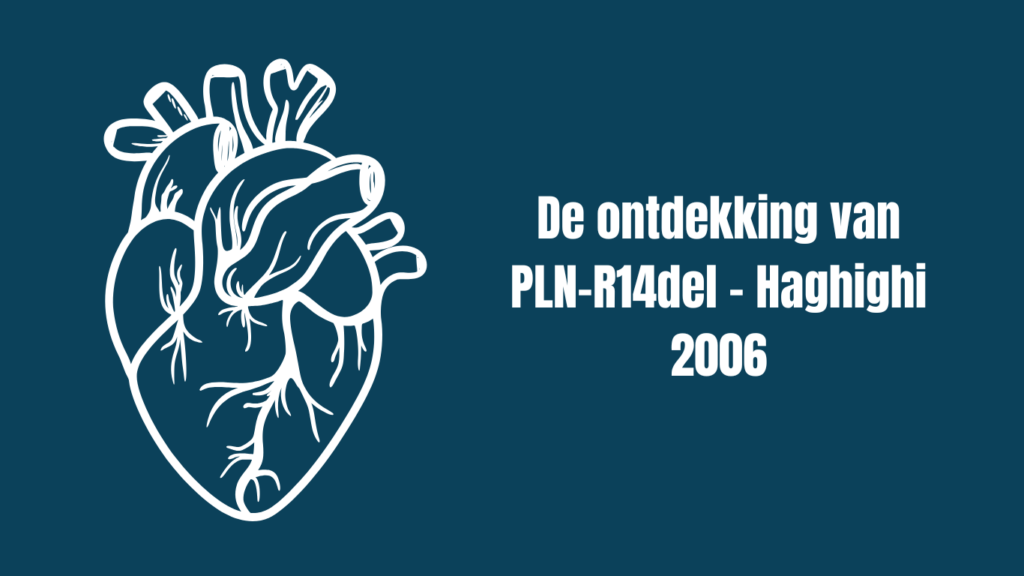Original article: Haghighi, 2006, PNAS A mutation in the human phospholamban gene, deleting arginine 14, results in lethal hereditary cardiomyopathy
The first scientific article on the R14del mutation appeared in 2006. By 2006, two mutations in PLN were known to also cause heart problems, but with different severity. Furthermore, researchers knew that PLN was very important in the heart. These two facts made researchers suspect that there are more changes in the PLN gene that cause heart problems.
To investigate whether there are more mutations in PLN, two large groups of heart patients were studied. These groups came from Greece and America and consisted of patients with heart failure. The study looked at which molecules make up the PLN gene by a technique called sequencing. Indeed, one patient was found to have a change in the PLN gene. Three molecules were found to be gone from the DNA.
This caused one of the fifty-two amino acids of the PLN gene to be absent. This patient came from a family with heart problems. The patient herself had since died from heart failure and her mother, aunt and sister had also died from heart problems. Both her daughters and two nieces were also found to have the change in the PLN gene. So this already showed how severe the mutation can be.
The heart of the first PLN carriers
What does the heart look like in the first PLN carriers? Heart tissue collected during cardiac catheterization was available from a number of carriers. Staining and microscopy revealed connective tissue in the heart. Heart cells also showed a disrupted structure. Both findings may contribute to less pumping power of the heart and thus fit the heart failure the patients developed. An important finding was that carriers of the PLN gene regardless of whether they were sick or healthy were found to have changes on their cardiac video. The heart movie showed in all carriers that the chambers were less activated.
The next step was research in the lab: what does the change in the gene do in cells and in animals? In this article, we won’t go through the details because some insights are already outdated and other research goes into this in more detail. What is important is that the research in cells and in animals found the same problems as in patients. This makes it possible in these cells and mice to further study the disease and work on a solution.
The researchers concluded that PLN and the pathway in which PLN is active is indeed very important in the heart and that changes can result in heart problems. A few years later, the same mutation was also found in Germany. This was followed by the discovery in the Netherlands which we will cover in a subsequent article.
Background
This research was conducted under the direction of Professor Evangelia Kranias. Professor Kranias is of Greek origin, but made her studies and career in the United States (hence this study includes both Greek and American patients). Her research focused mainly on phospholamban which is why she is also called the mother of phosphoslamban. In her research, Professor Kranias has been instrumental in understanding how phospholamban works. In addition, she is the research leader of the transatlantic CURE-PLaN project (2019-2024), a large study entirely on PLN-R14del. This consortium is now complete.
Deepening
How do we know that a change causes disease?
Our DNA changes. This is due to errors in DNA copying (although this is done incredibly accurately), toxic substances, UV and more. A lot of these changes are harmless because they are in a piece of DNA that is not translated into a protein. Other changes cause disease.
How do we know if a change is a random change or causes disease? There are a number of questions researchers ask to find out: (1) does a change occur in sick individuals but not in healthy individuals? This was found to be the case for PLN; (2) is the piece of gene the same in different animal species? We are very different from animals so if a piece of gene is exactly the same in different animals, it might be necessary for the function of the gene.
The piece of gene surrounding R14 was found to be exactly the same in animals; (3) do we know if the piece of gene is involved in the function of the protein? R14 is located where PLN normally binds to another protein, so that R14 is now missing could disrupt that binding; (4) what kind of change is it? Some changes in the gene lead to a protein that is only slightly different.
In PLN, there really is a molecule missing from the protein, so the change is larger; (5) finally, what happens if you introduce the change into cells or animals? If the cells or animals get sick because of this one change, that is a strong indication that the change causes the disease. As you understand: really proving that a change causes disease is not so easy.
